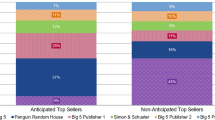Abstract
The paper examines the impact on a firm’s price when it faces the possibility of an antitrust investigation and associated potential revenue penalty. As well as presenting a general model of antitrust intervention, an illustrative example reflecting the provisions of the 1998 UK Competition Act is offered, the example being developed to explore the implications of the probability of antitrust intervention and punishment increasing non-linearly as a firm’s profit rises.
Similar content being viewed by others
Notes
Acutt and Ellidott (2001) discuss key requirements for the efficacy of threat based antitrust policy, including the ability of antitrust authorities to detect market power abuses and to develop a reputation for intervention once abuses have been detected.
Note that the empirical analysis of Block et al. (1981) also supports the notion that the threat of large penalties can have an impact on price-cost mark ups.
Throughout the paper a firm may enjoy positive profits, even in the face of revenue penalties. While the assumption of positive, fixed costs of production will not affect the equilibrium price, it will affect the results to the extent that a firm’s profits may become negative when a revenue penalty is imposed, depending on the magnitude of the fixed costs. A firm may then choose to leave the market.
See corresponding author for calculation details throughout Section 4.
References
Acutt, M. and Elliott, C., “Threat-based competition policy,” European Journal of Law and Economics, vol. 11, pp. 309–317, 2001.
Acutt, M., Elliott, C., and Robinson, T., “Credible regulatory threats,” Energy Policy, vol. 29, pp. 911–916, 2001.
Bawa, V.S. and Sibley, D.S., “Dynamic behavior of a firm subject to stochastic regulatory review,” International Economic Review, vol. 21, pp. 627–642, 1980.
Block, M.K., Nold, F.C., and Sidak, J.G., “The deterrent effect of antitrust enforcement,” Journal of Political Economy, vol. 89, pp. 429–445, 1981.
Christiansen, A. and Kerber, W., “Competition policy with optimally differentiated rules instead of “Per se rules vs. Rule of reason,” Marburg Papers on Economics, no. 06–2006, 2006.
Evans, D.S. and Padilla, A.J., “Excessive prices: Using economics to define administrative legal rules,” Journal of Competition Law and Economics, vol. 1, pp. 97–122, 2005.
Glazer, A. and McMillan, H., “Pricing by the firm under regulatory threat,” Quarterly Journal of Economics, vol. 107, pp. 1089–1099, 1992.
Harrington Jr., J.E., “Some Implications of Antitrust Laws for Cartel Pricing.” Economics Letters vol. 79, 377–383, 2003.
Harrington Jr., J.E., “Cartel pricing dynamics in the presence of an antitrust authority,” RAND Journal of Economics, vol. 35, pp. 651–673, 2004.
Harrington Jr., J.E., “Optimal cartel pricing in the presence of an antitrust authority,” International Economic Review, vol. 46, pp. 145–169, 2005.
Klevorick, A.K., “The behavior of a firm subject to stochastic regulatory review,” Bell Journal of Economics and Management Science, vol. 4, pp. 57–83, 1973.
Logan, J.W., Masson, R.T., and Reynolds, R.J., “Efficient regulation with little information: Reality in the limit?” International Economic Review, vol. 30, pp. 851–861, 1989.
Souam, S., “Optimal antitrust policy under different regimes of fines,” International Journal of Industrial Organization, vol. 19, pp. 1–26, 2001.
Taylor, W.E. and Zona, J.D., “An analysis of the state of competition in long-distance telephone markets,” Journal of Regulatory Economics, vol. 11, pp. 227–255, 1997.
Zweifel, P. and Crivelli, L., “Price regulation of drugs: Lessons from Germany,” Journal of Regulatory Economics, vol. 10, pp. 257–273, 1996.
Acknowledgement
We would like to thank Mick Howard, Peter Lukacs, Sir Derek Morris, Bob Rothschild, seminar participants at the Universities of Sydney, Leopold-Franzens Innsbruck and Manchester Metropolitan, and the participants of the Australian Conference of Economists, Perth and the Margaret River Workshop on Growth and Development in the Global Economy for helpful comments. All errors remain the authors’ responsibility.
Author information
Authors and Affiliations
Corresponding author
Additional information
The views expressed in this paper are those of the authors and should in no way be attributed to their employers.
Appendix
Appendix
Second order condition to be satisfied to ensure that profits are in fact maximized in Eq. 1:
Rights and permissions
About this article
Cite this article
Elliott, C., Acutt, M. Antitrust Policy: The Impact of Revenue Penalties on Price. J Ind Compet Trade 7, 1–8 (2007). https://doi.org/10.1007/s10842-006-0002-6
Received:
Revised:
Accepted:
Published:
Issue Date:
DOI: https://doi.org/10.1007/s10842-006-0002-6



